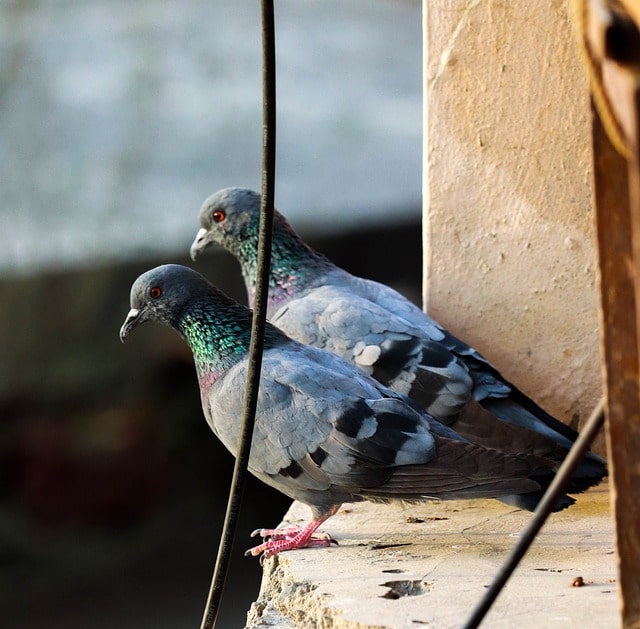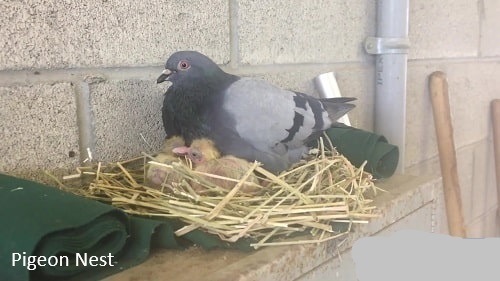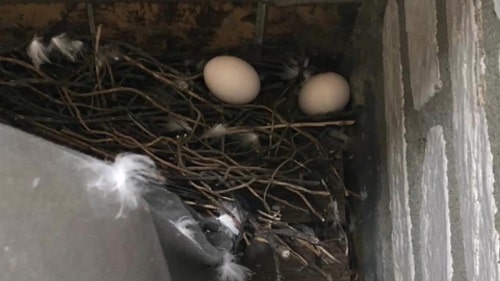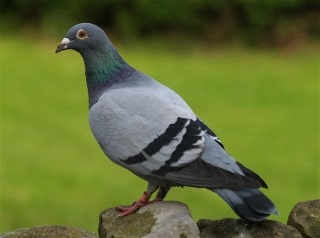Guide to the Pigeons Mating, Nesting, & Reproduction Behaviors (2025)
Last updated: April 25, 2025
A hands-on explainer for backyard birders covering the Pigeons mating, nesting and breeding season along with practical ways to discourage unwanted nesting.
At a Glance:
- Nesting: Pigeons nest on ledges, rafters, and bridges.
- Mating: Pairs often stay together for life and can raise 6+ broods a year.
- Young: Squabs are fed crop milk and hidden until fully feathered around 28 days.
- Diet: Ground feeders that eat seeds, grains, and human scraps in urban areas.
- Lifespan: 3 to 6 years in the wild, up to 15 in captivity with care.
Commonly known as the pigeon, rock dove, or European rock dove. Its scientific name is Columba livia.
While some consider pigeons nesting around them to be a nuisance, others, like me, find them special. You see, Pigeons are what sparked my interest in birds.
In this post I'll discuss the pigeon's unique nesting, mating, and feeding habits. So join me as we discover the world of the so-called Common Pigeon.
Introduction
Introduced into North America from Europe in the 1600s, these birds have been associated with humans for thousands of years.
Pigeons are thought to have been the first domesticated bird, raised for meat as far back as the time of the ancient Egyptians.
Identifying Pigeons, Size - Field Marks
Pigeons have different colors due to breeding by humans. They are the descendants of the wild Rock Dove of Europe.

About 13 inches in length with a dark gray small head, iridescent neck, plump body, light gray back, and 2 dark wing bars.
Mate Selection - Breeding
Pigeons have an interesting courtship ritual. The male begins by selecting a potential nest site, carefully choosing a location within the female's view.
This display serves as a demonstration of his territory and his ability to provide for a family. The female observes the male's choice, assessing his suitability as a mate.
She's essentially evaluating his ability to protect and provide for their future offspring.
To impress her further, the male performs a courtship dance. He circles the female, bowing and cooing softly, while puffing out his crop.
This elaborate performance usually signals their readiness to mate which begins with shared preening followed by copulation.

Nest Building - Construction
In cities, the Pigeon's nest may be built on a buildings and bridges. In more rural areas, barns are used regularly.
The nests itself will be built on the ledges, rafters, and other framing parts of these structures.
The process is begun by the male selecting a stick and bringing it back to the site and laying it in front of his mate.
The female accepts the each stick brought by the male and arranges them beneath her to build the nest.
A loose saucer or bowl-shape is built using stems and leaves as nesting material.
Pigeon Egg Laying Details
Interesting to note, females can lay eggs at 6 months of age although most begin after their first year.
Before laying, the female may sit on the nest a day or two. This helps her establish a sense of security, and to begin regulating her body temperature in order to lay eggs.
Pigeons usually lay 2 white eggs in each clutch. Only one egg is laid each day.
Both the male and female will incubate the eggs, but the female will be the one spending the most time on the eggs sitting from mid-afternoon to mid-morning.
How Long Before Eggs Hatch?
Pigeon eggs will hatch within 17 - 19 days from the start of incubation. Incubation and not gestation period is the term used with birds.
When the eggs hatch, the young are covered in yellow down.
Young pigeons in the nest are referred to as "squabs" although people like to call them chicks or pigeon nestlings.
| Reference Table: Pigeon Reproduction Habits | |
|---|---|
| Eggs | 2 |
| Incubation | 17 - 19 days |
| Nestling Phase | 28 days avg. |
| Broods | Can Breed All Year |
Initially, the squabs (baby pigeons) are fed what is referred to as crop milk. This is a regurgitated thick liquid food that comes from the parent's crops.
At about 10 days, the squabs are fed increasing amounts of the food types that adults eat and are no longer dependent on crop milk.
The young will double in size in a day and a half. Making them one of the fastest-growing vertebrates in the world.
Within 2 weeks, the flight feathers begin to emerge and by week 3 the squabs are covered in feathers.
The tail and full feathering are completed by the 28th day and their weight is that of an adult.
By day 28 onward the young will leave the nest and the male will teach them what they need to know to survive.
This is 10 - 15 days longer than most of our backyard birds.
The female will begin a new clutch and this cycle will repeat about every 30 days when the weather cooperates.
When Do They Nest?
The primary pigeon mating season begins in March and can go through June with a pause until August through November.
It's not uncommon for pigeons to mate, lay eggs, and raise six batches of young each year.
Do Pigeons Reuse the Same Nest?
It's more accurate to say that the same pigeon nest site is used rather than the nest itself. Second and subsequent nests may be built on top of the first nest.
Older nests have been measured to be as much as 7 inches high and 19 inches wide.

Do Pigeons Mate for Life?
Like Mourning Doves, Pigeon pairs are monogamous, often breeding in consecutive seasons for as long as both birds of a pair live.
This is the definition of Pigeons mating for life even though if one dies, the other will find a new mate.
Most will attempt to raise several broods each year. Sometimes as many as four or six broods will be raised by a mated pair in a single year.
The breeding season of pigeons can be all year provided climate conditions allow. Breeding begins slowing down or stopping during mid-summer and the winter months.
How Do Pigeons Mate? Reproduction
The reproduction process of pigeons is like most birds, by copulation. The female will crouch down, the male mounts her and fertilizes the female. This process takes about 2 seconds.
Copulation may occur several times per day and may go on for a week or more. After the first egg is laid, focus is turned toward incubation duties.
Feeding Habits - Diet
Rock Pigeons feed on the ground. To prevent seed spoilage and to keep the birds healthy, a ground feeder is recommended for all ground-feeding birds.
The best types of food to offer these birds are properly mixed seeds specifically made for doves and pigeons.
For more information on seeds and photos of each, please see our Bird Seed Page.
Predators of Pigeons?
The primary predators of pigeons include humans, Peregrine falcons, and cats. In the nest, predators include opossums, raccoons, crows, and owls. Hawks will capture perching birds.
Why Are Their Nest So Bad?
Pigeon nests can be seen as bad for several reasons. Firstly, pigeons are known to be prolific breeders, and their nests can quickly multiply in number.
This can lead to an large flocks of pigeons in urban areas, which may result in issues such as excessive noise, droppings, and damage to buildings.
Another reason why pigeon nests can be bad is because they can also pose health risks. Pigeon droppings can carry diseases and parasites, which can be harmful to humans.
Additionally, the accumulation of droppings and feathers in nests can attract other pests like mites, ticks, and fleas.
And then there is the aesthetic perspective, pigeon nests can be considered unsightly.
They can create a messy appearance, especially when they are built in urban areas or on structures such as buildings, balconies, or rooftops.
It's important to note that this does not make pigeons bad.
Discouraging Nesting
Pigeons are known for their adaptability and often seek out convenient nesting spots. If you're looking to discourage them from nesting in unwanted areas, consider the following strategies.
- Physical Barriers: Install bird spikes, nets, or sloped surfaces on ledges, balconies, or other potential nesting sites to prevent pigeons from landing.
- Repellents: Use visual or auditory deterrents, such as reflective tape, wind chimes, or noise-making devices, to create an unwelcoming environment.
- Remove Food Sources: Ensure that outdoor areas are free of food scraps or open garbage that may attract pigeons. Secure trash bins and avoid feeding birds in unwanted areas.
- Regular Inspections: Frequently check for signs of nesting activity, especially in the spring and summer months when pigeons are most likely to nest.
- Nest Removal: If you find a nest, it's essential to remove it carefully. Ensure that the nest is empty (i.e., without eggs or chicks) before removal, as this can be subject to wildlife protection laws. Use gloves and a mask for safety, and dispose of the nest materials properly.
- Check With Pest Professionals: If you're dealing with a persistent pigeon problem, consider consulting a pest control professional who can provide humane solutions.
By implementing these strategies, you can help deter pigeons from nesting in areas where you don't want them.
Are They Smart Birds?
According to Professor Richard J. Herrnstein at the Harvard Psychological Laboratories, they are. Pigeons were smart enough to learn all the letters of the English alphabet.
In another study, Pigeons were able to recognize themselves in a mirror. This makes them one of six species and the only non-mammal to be able to do so.
So yes, Pigeons are pretty smart birds.
How Long Do They Live?
Pigeons may live 3 - 6 years in the wild, with the average being 3 - 4 years.
In captivity, in a proper pigeon loft nest box, lifespans of 15 years have been recorded.

No matter where they live, whether in the UK, India, or the US. wild pigeons are short-lived, but if kept in captivity, they can live long lives with proper care.
Why Are Baby Pigeons Rarely Seen?
Baby pigeons, called squabs, remain hidden in their nests until they are nearly adult size. Pigeons nest in secluded, hard-to-reach places like building ledges and bridges, which protects the young from predators but also keeps them out of public view.
Have Your Say! Got an interesting story and a picture or two about pigeons in your backyard? Please Share it With Our Visitors. To share, start here Share My Pigeon Story
Fun Facts About These Birds
Pigeons can see about 26 miles.
When fully feathered, adult pigeons have around 10,000 feathers.
There are approximately 400 million pigeons in the world.
The average flight speed of pigeons is 60 - 77.6 miles per hour. The fastest speed is just over 90 miles per hour (racing pigeon).
You can learn about candling and hatching Pigeon bird eggs with this article.
You May Also Be Interested in Raising Doves.
pigeons intelligence studies citation: Pigeons.
Have A Great Story About Pigeons
Do you have a great story about Pigeons? Share it!






